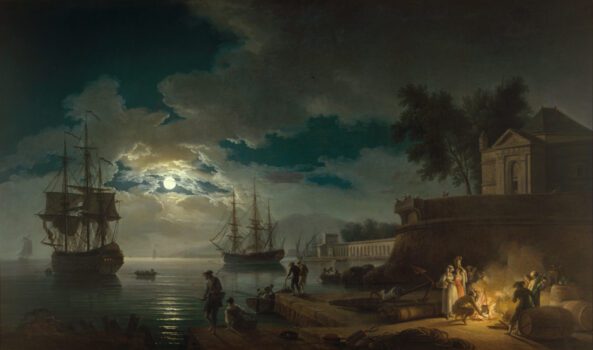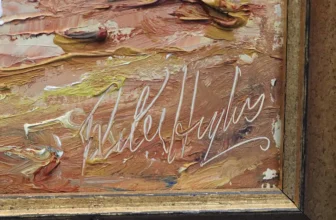The Story of Claude Joseph Vernet’s A Mediterranean Port, A Sea Port by Moonlight
Amidst the shimmering waves of moonlit waters, where ships rest in quiet anticipation and humanity finds its place in the grand theater of nature, Claude-Joseph Vernet paints a vision that transcends mere representation. A Mediterranean Port, also known as A Sea Port by Moonlight, is more than a landscape, it is a philosophical reflection, a poetic tableau, and a masterwork of 18th-century art. Through his skillful orchestration of light, shadow, human figures, and seascape, Vernet invites us into a world that exists somewhere between reality and reverie.
In this post, we’ll delve deeply into the painting’s meaning, its artistic context, the symbolism encoded in its moonlit narrative, what exactly is happening in the painting, what genre of art it belongs to, and where the original work resides today.
Who Was Claude-Joseph Vernet?
Before diving into the painting itself, understanding the artist is key. Claude-Joseph Vernet (1714–1789) was one of France’s most accomplished landscape and marine painters. Born in Avignon and trained in Rome, Vernet mastered the fusion of classical landscape traditions with natural observation. He became renowned for his seascapes, which often depicted ports, storms, and the quiet drama of maritime life with a sublime sensibility.
His fame grew rapidly after he was commissioned by King Louis XV to paint a series of French seaports, Les Ports de France. However, Vernet’s appeal stretched beyond topographical documentation. His works carried an emotional and atmospheric depth that placed human activity within the greater forces of nature, light, weather, and time.
What Is A Mediterranean Port / A Sea Port by Moonlight All About?
This painting, often referred to by both titles, A Mediterranean Port and A Sea Port by Moonlight, is one of Vernet’s quintessential nocturnes. It portrays a quiet scene at a seaport, bathed in the ethereal glow of moonlight. The setting is not definitively identified, though its classical Mediterranean features, arched architecture, fishing boats, rocky outcrops, situate it firmly within the idealized southern European coast that Vernet loved to depict.
Yet this is no ordinary depiction of a port. It’s an imagined scene, inspired more by poetic atmosphere than geographical specificity. The painting is suffused with a sense of calm and mystery. The moon, suspended in the heavens, reflects off the gently rippling water. People, silhouetted in the foreground, go about their nighttime tasks, loading goods, mending sails, conversing in hushed tones. Fires glow gently, lanterns flicker, and the hush of the ocean dominates all.
At its core, A Sea Port by Moonlight is a meditation on the relationship between man and nature, activity and stillness, transience and eternity.
What Is Happening in the Painting?
At first glance, the painting may appear to simply portray a moment of maritime life. But closer inspection reveals a layered narrative.
In the foreground, figures are seen gathered near a small bonfire or torchlight. One might be a fisherman, resting after a day’s labor. Another could be a merchant overseeing cargo. There’s a sense of routine, yet something reverent in their calmness.
A sailing vessel is anchored close to the dock, partially illuminated by moonlight. It is neither in distress nor action, it waits, as if for dawn or the next tide.
The harbor’s architecture, likely inspired by Roman or classical ruins, adds a sense of ancient permanence, even as the sea erodes its edges.
In the background, the moon dominates the sky, its soft beams stretching across the water and lending the whole scene a dreamlike quality.
Unlike dramatic maritime scenes depicting storms or battles, this is a portrait of stillness. Life continues under the gaze of the moon. It is a snapshot of tranquility, activity folded into the natural rhythms of the world.
Symbolism and Interpretation: The Deeper Meaning Behind the Moonlight
1. The Moon as a Symbol of Time and Reflection
The moon in this painting is more than a light source, it is the spiritual center of the composition. Its symbolism is manifold:
Time and Cycles: The moon, tied to the tides and calendars, represents the passage of time and the cycles of life.
Contemplation and Dreams: Unlike the sun, which is active and rational, the moon often symbolizes the unconscious, intuition, and mystery. Vernet’s choice to depict a nighttime harbor evokes a world of contemplation rather than commerce.
Duality: The moonlight highlights contrasts, light and shadow, movement and stillness, nature and civilization.
2. The Sea as the Infinite and the Sublime
In 18th-century aesthetics, particularly influenced by Edmund Burke’s concept of the sublime, the sea often represented nature’s boundless and awe-inspiring power. In Vernet’s painting:
The sea is calm, yet its vastness still looms, a quiet reminder of nature’s scale.
It is a threshold, between land and unknown waters, between day and night, between the human and the divine.
3. Human Figures as Part of a Larger Order
Rather than heroic protagonists, the human figures are small, humble. They do not command the scene, they inhabit it. This reflects Enlightenment-era sensibilities where human beings, while rational and industrious, were also understood as part of the natural order. The figures:
Represent the everyday rhythms of labor and community.
Are scaled to suggest humility, they are not larger than life, but part of it.
4. Architecture as Legacy and Decay
The buildings in the painting, arches, columns, facades, invoke the grandeur of classical civilizations, now repurposed as a backdrop to working life.
These ruins or structures may symbolize civilizational endurance, but also its impermanence.
They are both monumental and ordinary, used in the service of daily human endeavors.
What Type of Art Is A Sea Port by Moonlight Painting
Claude-Joseph Vernet’s A Sea Port by Moonlight is an exquisite example of 18th-century landscape painting, drawing on elements from both Baroque and Neoclassical traditions. More specifically, it falls into the genre of marine art or seascape painting, with a strong influence of the sublime and picturesque.
Key characteristics of this style in the painting include:
Chiaroscuro: The interplay of light and shadow, especially the gentle moonlight contrasting with the warm firelight, is masterful.
Atmospheric Perspective: Vernet uses light to create depth, leading the viewer’s eye from the foreground figures to the distant horizon.
Narrative Composition: Though it’s a landscape, it tells a story, with characters placed carefully to suggest action, rest, and reflection.
Idealized Realism: While the setting is not strictly real, it feels authentic, balancing accuracy with emotional resonance.
Vernet was influenced by both Italianate classicism and Dutch marine painters like Willem van de Velde. His unique synthesis of these styles made his work beloved across Europe, particularly among collectors who prized evocative, lyrical landscapes.
Where Is A Sea Port by Moonlight Painting Today?
The painting, known as A Sea Port by Moonlight, is part of the permanent collection of the National Gallery in London, one of the most prestigious art institutions in the world. Its catalogued title may vary slightly, as multiple versions or similar works exist due to Vernet’s prolific career and frequent commissions.
Visitors to the gallery can view the painting up close and witness the subtle mastery of Vernet’s brushwork, the translucence of the moonlight, the gentle glimmer on the water, the textured masonry of the harbor structures.
Why It Still Resonates
Vernet’s Sea Port by Moonlight endures not simply because of its beauty, but because of its philosophical depth. In an age increasingly obsessed with speed, noise, and spectacle, Vernet’s painting reminds us of the poetry of stillness. It encourages viewers to look again, to find meaning not just in action, but in the spaces between.
This painting invites introspection. It asks: What does it mean to work, to live, to dream under the eternal moonlight? How do we place ourselves in the continuum of time, amidst the ebb and flow of nature and civilization?
In the quietude of this port scene, Vernet captures something essential about human life, our smallness and significance, our rhythms and reflections, our transient lives under the watchful gaze of eternity.
Claude-Joseph Vernet’s A Sea Port by Moonlight is a painting that lives between worlds. Between land and sea, light and shadow, labor and leisure, history and eternity. Through its intricate composition and subtle symbolism, it evokes a timeless moment, a pause in the rush of life when everything becomes still, and the soul listens.
As you stand before it, in person or in thought, you too become part of its world. A witness to the quiet dignity of human life under the moon’s silver light. A reminder that even in the smallest harbor, beneath the darkest skies, beauty and meaning await those who look with patience.




